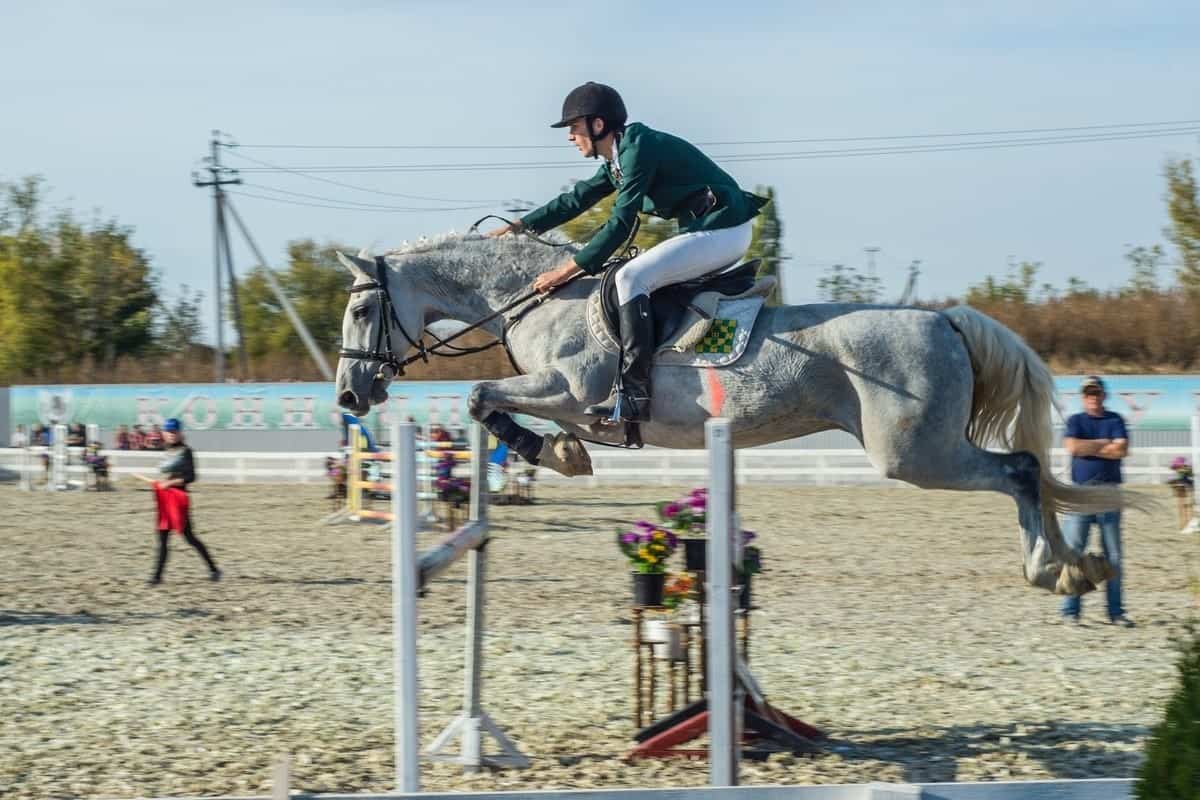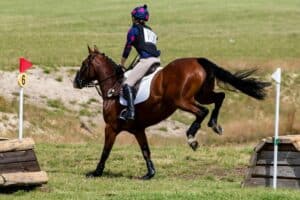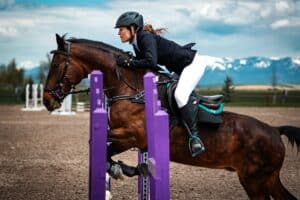Cross country is a type of English horse riding in which a rider must jump over 30 to 40 obstacles within a fixed amount of time. Cross country horse riding is a test in which a rider and the horse are tested for its endurance. The rider may have to face penalties in case of if they exceed the allocated time or the horse refuses to clear an obstacle.
Cross country is a sport in which a rider and his horse tackle a long course with jumps and other obstacles. It is designed to stimulate the riding experience of the countryside. It is also known as endurance riding.
What does the sport test?
Cross country horse riding is the test for determining three qualities:
- Speed of the horse
- Endurance of the horse
- skills of the horse
Cross country also tests the obedience of the horse to the rider and the way the rider handles the horse.
Failure to demonstrate even one of the three testing qualities lead to a deduction of score of the participant. For cross country riding, it is a must for a rider to have trained for enough time to succeed in the real competition. The skills tested in the competition can only be demonstrated if the rider and the horse are acquainted with each other. This can only be possible when the rider and the horse have been training for a very long time to achieve a state of perfection. Moreover, the horse is required to show obedience to the rider otherwise the horse may refuse to cross obstacle in the middle of the game which can reduce the chances of the participant winning the competition.
Sometimes odd materials or obstacles may be placed in the course to test the horse’s bravery.
Cross country events
Cross country riding may be played exclusively in the form of hunter trails or as a part of three days eventing competition.
Hunter trails are cross country competitions in which riders can compete as pairs or individuals. The rider must complete the course in a certain time. The competition is made up to stimulate actual hunting conditions.
Eventing is a form of equestrian competition in which a competitor must participate in three different horse riding contests. Cross country jumping is one of the three events which are played in the evening. It always comes after dressage in an eventing competition.
Cross country course
Cross country course is the route and a pre-determined set of obstacles which a horse and its rider must follow during the competition. A cross country course may be from 4 km to 6km. It consists of around 24 to 36 obstacles. Unlike showjumping where horses are jumped over soft and safe obstacles, the obstacles are hard but for safety reasons most of the obstacles are built with a “fragile pin system” allowing a part or the whole obstacle to collapse if the obstacle is hit with sufficient force.
Cross-country courses are always outdoor. The terrain may be unique for each course it incorporates.
In a cross-country course, there are some passages which are flagged in certain colors, meaning that the rider has the option to choose another route if he wants without facing any penalty.
Cross country jumps and obstacles
There are a variety of jumps and obstacles which may be placed in the course. Some of the most common jumps and obstacles are as below:
- long fence
Single or multiple tree trunks placed horizontally.
- Corner
Triangular in shape. Require horse to jump over one corner.
- Gate
A fixed wooden fence made just like a typical countryside gate.
- Wall
A solid wall topped with a wooden beam.
- Coffin
Combination fence with three elements: a jump, a ditch and a a final jump.
- brush fence
Solid base with some brush placed on the top.
- Rolltop
A jump with rounded half barrel top.
- Water
Natural water stream or man-made. Horses will be required to splash through or jump in and out of the water.
The Art of Scoring: Every Point Counts
In cross country riding competition, the participant with the lowest scores wins. The participants are penalized for every mistake they make. Major mistakes can eliminate the participant from the competition. More penalties mean more scores. The rider and horses try to complete the course with the least number of penalties possible. The best score one can receive is ‘0 points’ which means that the rider and the horse have not received a single penalty and have completed the course in the allotted time.
Similarities and differences between eventing and hunter trails
Now that we’ve explored the basics of cross country horse riding, let’s delve into the nuances of two popular formats within the sport: Eventing and Hunter Trails.
Eventing Extravaganza
Eventing consists of three different horse-riding competitions, making it an exciting triathlon for both horse and rider. After the grace of dressage, cross-country jumping takes center stage. A harmonious combination of talent, speed, and endurance is needed to win this fast-paced sport.
It turns into a real test of their mettle as riders and their dependable horses thunder over a difficult course. The pair of riders has to make their way through a variety of well-placed jumps and obstacles on a landscape that is even more unpredictable. The pinnacle of equestrian athletics, dressage is the elegance that seamlessly blends into the adrenaline rush of cross-country jumps.
Hunter Trails: A Duel with the Elements
Hunter Trails, a more specialized cross-country sport, is at the other end of the range. Riding in these conditions is like being fully involved in the unpredictable nature of a real hunt. There’s a sense of pressure and excitement as the riders have to finish the course in the allotted time, and the clock is ticking.
The environment of Hunter Trails frequently has a unique taste, even though the principles of overcoming challenges are still the same. In this exciting journey, players embrace the spirit of the hunt in addition to competing against the clock.
Navigating Spontaneity in Cross Country Riding
Embracing the unpredictable essence of cross country riding, this section delves into how riders adeptly handle unexpected challenges, from abrupt weather changes to surprise obstacles.
Weathering the Storm: Adapting to Sudden Changes
Skilled riders plan ahead for unforeseen weather changes and use tactics to keep up their best performance in the face of wind, rain, or freezing temperatures.
Obstacle Surprises: Decisions in the Blink of an Eye
Unexpected challenges require prompt decision-making. Examine the mental acrobatics riders use to quickly negotiate obstacles, choosing whether to sidestep or face them head-on.
The Art of Adaptability: Resilience in the Face of Challenges
This section focuses on resilience as a general concept rather than on any particular case. Learn how riders develop the mental toughness to maintain concentration and ride with confidence by experiencing the spontaneity that characterizes cross-country riding.
Training for the Unforeseen: Simulating Spontaneity in Practice
Examine workout plans intended to replicate unforeseen circumstances. Learn how to handle spontaneity in cross-country riding with a comprehensive preparation that includes mental exercises and simulation courses with unexpected features.
In essence, this section underscores that in cross country riding, it’s not just about conquering planned obstacles; it’s about thriving in the unexpected, turning spontaneity into a testament of rider-horse collaboration.
Tackling Terrains: Embracing the Diversity of the Cross Country Landscape
One of the captivating aspects of cross country horse riding is the rich tapestry of terrains riders traverse during their exhilarating journey. The cross country course is a dynamic playground, presenting a myriad of challenges across diverse landscapes, from expansive fields to dense forests.
Cross-country riders follow paths that need flexibility and a variety of skills, much like navigators do. Successful cross-country riding requires riders to be adept at terrain analysis, which is a talent that is specific to each type of geography and presents its own set of problems.
1. Expansive Fields: The Open Canvas of Possibilities
A common feature of many cross-country courses is their vast fields. The large, open areas give riders a blank canvas of options, but they also present a challenge in terms of sustaining momentum and speed. Riders must strike a balance in this terrain between the rush of speed and the dexterity needed to clear leaps with ease. This section will examine how riders make tactical choices to overcome barriers without slowing down in order to take advantage of the expanse of fields.
2. Dense Forests: Navigating Nature’s Labyrinth
When you bike cross-country through dense forests, it becomes an agility and finesse challenge. Layers of intricacy are increased by trees, rocky terrain, and poor vision. We’ll look at the tactics riders used to get around the natural maze in this part. Learn the skill of navigating through dense woodlands without sacrificing accuracy or speed, from picking obvious routes to customizing your riding technique for the cramped conditions.
3. Varied Terrains: Adapting Riding Styles
Beyond fields and forests, cross country courses may incorporate a variety of terrains – rolling hills, water bodies, and more. Everybody adds a different element to the ride. Discover how cyclists modify their riding techniques to overcome stretches that are uphill or downhill, splash through water hazards, and keep a steady beat while traversing the diverse terrain. The purpose of this part is to provide riders a thorough understanding of the adaptability they need to overcome the many terrains seen on a cross-country course.
This landscape investigation essentially emphasizes that cross-country horseback riding is a dynamic dance with nature rather than just a physical activity. Through fields, forests, and all the various terrain in between, riders must become attuned to the subtleties of each landscape and form a seamless partnership with their horses in order to overcome difficulties and emerge victorious.
Mind Over Obstacles: Nurturing Mental Fortitude in Cross Country Riding
Mental toughness is crucial in the fast-paced world of cross-country horseback riding, where expertise and accuracy are needed for every jump, curve, and twist. This section explores the complex relationship that exists between the rider’s mental readiness and their ability to successfully complete the difficult course.
1. The Mental Landscape: Understanding the Psychology of Riding
Riding cross-country goes beyond simply jumping over hurdles. It’s a psychological voyage where participants must comprehend and control their mental terrain. Discover the psychology of effective cross-country cycling, from the nerve-wracking moments at the starting line to the need for focus during the middle of the ride.
2. Staying in the Zone: Techniques for Unwavering Focus
Maintaining unwavering focus throughout a cross country ride is a formidable task. This section will explore the several strategies cyclists use to stay in the zone. Readers will learn about the rituals and mental techniques riders employ to block out distractions and maintain laser-like focus on the work at hand, from developing a pre-ride routine to cultivating a concentration mindset.
3. Stress Management: Riding the Wave of Pressure
Cross-country riding is competitive, which means there is pressure and tension involved. Learn how riders can efficiently manage their stress so that it becomes an asset rather than a liability. This entails learning about breathing exercises, relaxation methods, and mental signals that let riders ride the pressure wave and use it as fuel for optimal performance.
In essence, this exploration of mental preparedness in cross country riding underscores that it’s not only about conquering physical obstacles but also about navigating the intricate terrain of the mind. The riders who master this mental dimension elevate themselves from competitors to true champions in the challenging world of cross country riding.
Conclusion: The Harmony of Cross Country Horse Riding
Cross-country horseback riding is a colourful piece in the bright tapestry of equestrian activities, demonstrating the symbiotic link between rider and horse. It’s more than just a competition; it’s an artistic dance with nature, where challenges present opportunity.
From vast fields to deep forests, the rider’s trip takes place in a variety of terrains, each offering a different difficulty. Beyond just physical prowess, the mental toughness required to remain focused, calm in the face of chaos, and manage stress elevates the sport to a comprehensive experience.
Cross-country riding is a celebration of the relationship between the rider and the horse, whether it is done for fun or competitively. Beyond victories, the tales inscribed on the course’s canvas speak to the passion, resiliency, and essence of this remarkable form of horsemanship. Cross-country riding is a romantic trip across fields and forests, marked by special moments shared between the rider and horse, rather than just a race to the finish line.



